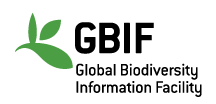| This article includes a list of general references, but it lacks sufficient corresponding inline citations. Please help to improve this article by introducing more precise citations. (November 2021) (Learn how and when to remove this message) |
 | |
| Type of site | Biodiversity, natural history |
|---|---|
| Area served | Worldwide |
| URL | www |
| Commercial | No |
| Launched | 2001; 24 years ago (2001) |
| Current status | Active |

The Global Biodiversity Information Facility (GBIF) is an international organisation that focuses on making scientific data on biodiversity available via the Internet using web services. The data are provided by many institutions from around the world; GBIF's information architecture makes these data accessible and searchable through a single portal. Data available through the GBIF portal are primarily distribution data on plants, animals, fungi, and microbes for the world, and scientific names data.
The mission of the GBIF is to facilitate free and open access to biodiversity data worldwide to underpin sustainable development. Priorities, with an emphasis on promoting participation and working through partners, include mobilising biodiversity data, developing protocols and standards to ensure scientific integrity and interoperability, building an informatics architecture to allow the interlinking of diverse data types from disparate sources, promoting capacity building and catalysing development of analytical tools for improved decision-making.
GBIF strives to form informatics linkages among digital data resources from across the spectrum of biological organisation, from genes to ecosystems, and to connect these to issues important to science, society and sustainability by using georeferencing and GIS tools. It works in partnership with other international organisations such as the Catalogue of Life partnership, Biodiversity Information Standards, the Consortium for the Barcode of Life (CBOL), the Encyclopedia of Life (EOL), and GEOSS. The biodiversity data available through the GBIF has increased by more than 1,150% in the past decade, partially due to the participation of citizen scientists.
From 2002 to 2014, GBIF awarded a prestigious annual global award in the area of biodiversity informatics, the Ebbe Nielsen Prize, valued at €30,000. As of 2018, the GBIF Secretariat presents two annual prizes: the GBIF Ebbe Nielsen Challenge and the Young Researchers Award.
See also
- ABCD Schema
- Atlas of Living Australia (ALA)
- Australasian Virtual Herbarium (AVH)
- Darwin Core
- Global biodiversity
- List of electronic Floras (for other online flora databases)
References
- ^ "What is GBIF?". gbif.org. Archived from the original on 2020-12-09. Retrieved 2017-08-30.
- O'Brien, Colleen (31 July 2017). "Open-source species location data supports global biodiversity analyses". Mongabay Environmental News. Archived from the original on 29 December 2021. Retrieved 29 December 2021.
- Heberling, J. Mason; Miller, Joseph T.; Noesgaard, Daniel; Weingart, Scott B.; Schigel, Dmitry (9 February 2021). "Data integration enables global biodiversity synthesis". Proceedings of the National Academy of Sciences. 118 (6): e2018093118. Bibcode:2021PNAS..11820180M. doi:10.1073/pnas.2018093118. PMC 8017944. PMID 33526679.
- "Big Data Accelerates Biodiversity Research – News – Carnegie Mellon University". cmu.edu. Carnegie Mellon University. March 26, 2021. Archived from the original on December 29, 2021. Retrieved December 29, 2021.
- "Ebbe Nielsen Challenge". gbif.org. Archived from the original on 2019-12-29. Retrieved 2022-01-12.
External links
- Official website
- Short description of GBIF Archived 2020-12-09 at the Wayback Machine
- GBIF network Archived 2020-12-16 at the Wayback Machine
- GBIF Data publishers Archived 2020-08-23 at the Wayback Machine